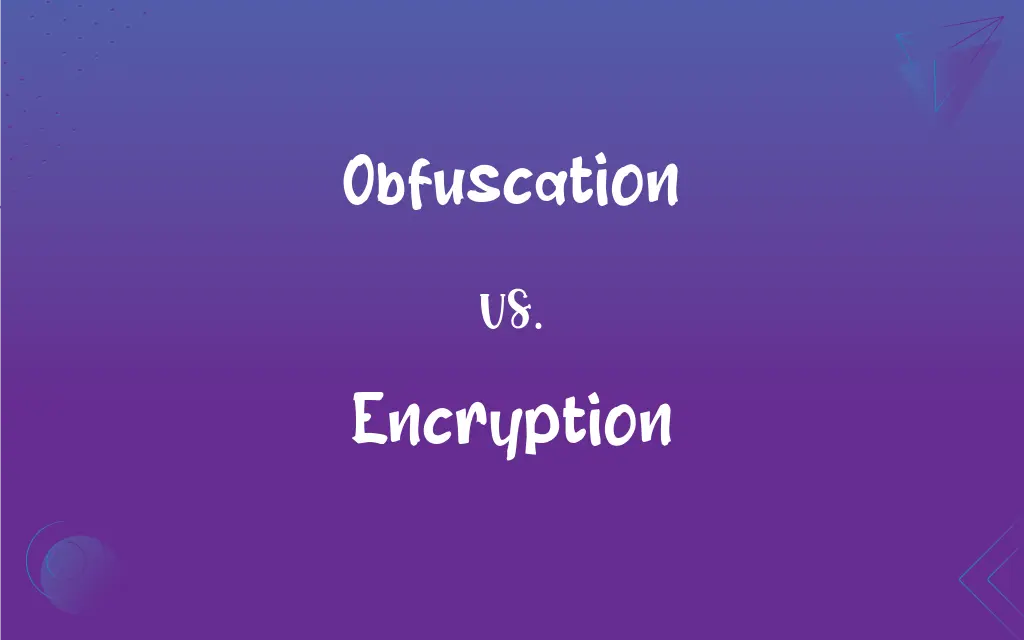Obfuscation vs. Encryption: What's the Difference?
Edited by Aimie Carlson || By Janet White || Published on January 23, 2024
Obfuscation is the process of making something unclear or difficult to understand, while encryption is the method of converting data into a code to prevent unauthorized access.

Key Differences
Obfuscation is the act of deliberately making something confusing or less clear, often to hide the true meaning or purpose. In contrast, encryption is a security measure that involves converting information into a code to prevent unauthorized access. Both serve to protect information, but their methodologies differ significantly.
The purpose of obfuscation is to make something difficult to understand, often to protect intellectual property or sensitive data from being easily comprehended. Encryption, on the other hand, is aimed at securing data by making it unreadable without a specific key or algorithm. While obfuscation alters the appearance or format of the data, encryption transforms the data itself into a secure format.
Obfuscation is commonly used in software development to protect source code from being easily readable, while encryption is widely used in data security to protect information during transmission and storage. Obfuscation doesn’t necessarily secure data but complicates its understanding, whereas encryption ensures data security by making it inaccessible without proper decryption.
Obfuscated data can often be reversed by someone with enough skill and time, as it doesn’t change the fundamental nature of the information. Encryption, however, requires a specific key or algorithm for decryption, making it a more robust method for protecting data against unauthorized access.
Obfuscation is often domain-specific, such as in coding or language, and is more about altering perception. Encryption is broader in application, used in various fields like digital communication, banking, and personal data protection, focusing on altering access rather than perception.
ADVERTISEMENT
Comparison Chart
Purpose
To make data unclear or less intelligible.
To secure data by converting it into a code.
Method
Altering appearance or format.
Transforming data into a secure format.
Reversibility
Often reversible with skill and time.
Requires a key or algorithm for reversal.
Security Level
Lower, as it doesn’t ensure data protection.
Higher, as it prevents unauthorized access.
Typical Use Cases
Software code protection, privacy.
Data transmission, storage, and security.
ADVERTISEMENT
Obfuscation and Encryption Definitions
Obfuscation
The act of clouding the truth.
His explanations were an obfuscation designed to mislead the inquiry.
Encryption
The process of converting information into a secure code.
Sensitive emails are often sent using encryption to protect the contents.
Obfuscation
The process of making something less clear.
The mystery novel used obfuscation to keep readers guessing until the end.
Encryption
A method of data security to prevent unauthorized access.
Encryption is essential for protecting online transactions.
Obfuscation
Deliberate ambiguity in communication.
The politician's speech was an exercise in obfuscation, leaving the audience confused.
Encryption
The act of coding messages for privacy.
Military communications employ encryption for operational secrecy.
Obfuscation
Complicating something to disguise its meaning.
The legal document was full of obfuscation to deter laypersons from understanding it.
Encryption
Securing digital information through coding algorithms.
Modern encryption algorithms are crucial for internet security.
Obfuscation
Making information intentionally vague.
The report was filled with technical jargon to obfuscate its true findings.
Encryption
Transforming readable data into an unreadable format.
To safeguard her diary, she used a simple encryption technique.
Obfuscation
To make so confused or opaque as to be difficult to perceive or understand
"A great effort was made ... to obscure or obfuscate the truth" (Robert Conquest).
Encryption
The process or result of encrypting data.
Obfuscation
To render indistinct or dim; darken
The fog obfuscated the shore.
Encryption
Cryptography.
Obfuscation
(uncountable) The act or process of obfuscating, or obscuring the perception of something; the concept of concealing the meaning of a communication by making it more confusing and harder to interpret.
Encryption
(cryptography) The process of obscuring information to make it unreadable without special knowledge, key files, or passwords.
Obfuscation
The alteration of computer code to preserve its behavior while concealing its structure and intent.
You need to turn on obfuscation for these classes.
Encryption
(cryptography) A ciphertext, a cryptogram, an encrypted value. Usually used with the preposition "of" followed by the value that is hidden in it.
Obfuscation
(uncountable) Confusion, bewilderment, or a baffled state resulting from something obfuscated, or made more opaque and muddled with the intent to obscure information.
Encryption
The process of converting messages in ordinary language, or other information into a secret coded form that cannot be interpreted without knowing the secret method for interpretation, called the key.
Obfuscation
(countable) A single instance of intentionally obscuring the meaning of something to make it more difficult to grasp.
During the debate, the candidate sighed at his opponent's obfuscations.
Encryption
The activity of converting from plain text into code
Obfuscation
The act of darkening or bewildering; the state of being darkened.
Obfuscation
Confusion resulting from failure to understand
Obfuscation
The activity of obscuring people's understanding, leaving them baffled or bewildered
Obfuscation
Darkening or obscuring the sight of something
FAQs
What is encryption?
Encryption is the process of converting data into a code to protect it from unauthorized access.
What is obfuscation?
Obfuscation is the practice of making something unclear or difficult to understand.
Can obfuscation be used for data security?
Yes, but it's less secure than encryption, as it only makes data hard to understand, not inaccessible.
What are common uses of encryption?
Securing online transactions, emails, and storing sensitive data.
How is obfuscation different from encryption?
Obfuscation makes data difficult to understand, while encryption makes data unreadable without a specific key.
Why is obfuscation used in coding?
To protect intellectual property and prevent easy understanding of the source code.
What are common uses of obfuscation?
Protecting software code and maintaining privacy in communications.
Can encryption be broken?
It's very difficult, but not impossible, especially with advancements in computing.
Is encryption reversible?
Yes, with the correct decryption key or algorithm.
Are there different types of encryption?
Yes, including symmetric and asymmetric encryption methods.
Is encryption legally required for certain data?
Yes, particularly for sensitive personal and financial information.
Is obfuscated data easy to reverse?
It can be, depending on the skill of the person attempting to understand it.
What makes encryption secure?
The use of complex algorithms and unique keys that are hard to replicate.
Does obfuscation affect data size?
It can, depending on the method used; some obfuscation techniques may increase data size.
Is encryption a modern invention?
The concept is ancient, but modern encryption methods are far more complex and secure.
What's an example of a simple encryption method?
Caesar cipher, where each letter in the plaintext is shifted a certain number of places down the alphabet.
Can obfuscation alone protect sensitive data?
Not effectively; it's better used in conjunction with other security measures like encryption.
Is obfuscation a form of encryption?
No, they are different processes; obfuscation disguises data, encryption secures it.
Can obfuscation be automated?
Yes, there are tools and software that can automatically obfuscate code or data.
What is a key in encryption?
A key is a piece of information used in an algorithm to encrypt and decrypt data.
About Author
Written by
Janet WhiteJanet White has been an esteemed writer and blogger for Difference Wiki. Holding a Master's degree in Science and Medical Journalism from the prestigious Boston University, she has consistently demonstrated her expertise and passion for her field. When she's not immersed in her work, Janet relishes her time exercising, delving into a good book, and cherishing moments with friends and family.
Edited by
Aimie CarlsonAimie Carlson, holding a master's degree in English literature, is a fervent English language enthusiast. She lends her writing talents to Difference Wiki, a prominent website that specializes in comparisons, offering readers insightful analyses that both captivate and inform.







































































